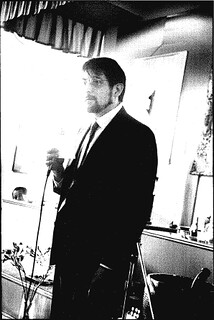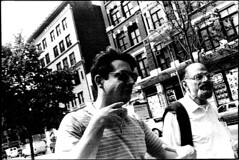 Paula Litsky Bob Rosenthal at Ginsberg’s funeral.
Paula Litsky Bob Rosenthal at Ginsberg’s funeral.It’s the last day of National Poetry Month, so here’s the final installment of our interview with Bob Rosenthal, conducted at Allen Ginsberg’s old 12th Street apartment, where Mr. Rosenthal worked as his secretary for nearly two decades. (Parts one, two, and three of this leisurely conversation ran last week.) As Ginsberg grew older and ill, his assistant followed him to a 14th Street loft purchased from the painter Larry Rivers; when Ginsberg died in 1997, Mr. Rosenthal became executor of the poet’s estate and guardian of one of his last meals.
Allen’s Addictions
Allen always had some pot around – he was a pot propagandist and so if a joint was being passed around and someone was going to take a photograph he would grab the joint so he’s got it. But actually, I rarely ever saw him smoke. He had pot for boyfriends – it’s a good line: “Oh, you want to come up and smoke?” It was really for them. He would go to LSD conventions with the big guys – the Fitz Hugh Ludlow Library guys, Huxley and all those guys. They would give him acid and he would come home and put it in the refrigerator and that was cute. There was a little vial of LSD and it said “Do not take without permission of Allen or Bob” – so I guess Bob had permission. So that was nice. But I never saw him on LSD. Read more…
 Rosenthal and Ginsberg.
Rosenthal and Ginsberg.Earlier this week, Allen Ginsberg’s secretary of 20 years, Bob Rosenthal, shared memories of his former employer – some of which will be included in a memoir he recently completed, “Straight Around Allen.” Speaking to The Local at Ginsberg’s former apartment on East 12th Street, where the two worked alongside each other for so long, he recalled the great poet’s daily routine, his tastes in literature and music, his mail and telephone communications, and his ways with money. Today, in our second installment, Mr. Rosenthal talks about Ginsberg’s social sphere during his two decades in the so-called poets building. Check back tomorrow for still more from this candid interview.
Allen’s East Village
People would always call Allen and say, “Allen, come to my shangri-la in Hawaii,” and here or there. He would never go. A vacation for Allen was coming back and having nothing to do in the East Village. He would often go to the poetry readings at St. Mark’s. He loved the mushroom barley soup at the Kiev. And The New York Times – he just loved it. He hung around Tompkins Square, wrote a lot of one-line poems about skinheads there. And he was a natural. I think because he always felt free here. Read more…
Gothamist has a nice long chat with Alex Gibney, director of “Magic Trip,” now playing at Cinema Village. The film documents Ken Kesey’s legendary 1964 road trip to New York. At the time, Allen Ginsberg, who makes an appearance partying with Jack Kerouac, was living at 704 East Fifth Street. “Ginsberg is still on fire,” Gibney says of the footage, “You can see him; just exploding with vitality and ideas and charm. Kerouac is a broken man at that point.”
 Tim Schreier A scene from this weekend’s Howl! Festival. Below: The cover of “Jack Kerouac and Allen Ginsberg: The Letters.”
Tim Schreier A scene from this weekend’s Howl! Festival. Below: The cover of “Jack Kerouac and Allen Ginsberg: The Letters.”Paul Rosenfeld, the critic, once wrote that, “Complex works of art speak not through individuals but ensembles.” In the early 1940s, on the steps of Columbia University, the original members of what became known as the “Beat Generation” — Jack Kerouac, Allen Ginsberg, Lucien Carr, William Burroughs — would form such a group.
The early Beats would strike off in several directions, on paths that would volley between the coasts and across the world, but they often returned to the Lower East Side where they got their start, and where their contribution to modern culture is celebrated in events like the Howl! Festival, named for Ginsberg’s game-changing 1955 poem. Ginsberg would have turned 85 years old last week — sufficient reason to look again at the passage of the Beats through our neighborhood and the influence they left.
The cheap apartments in the East Village in the 1940’s and 1950’s and the bohemian coffee houses and bars of downtown were a fecund soil for creative energy and experimental art. Ginsberg had the deepest connections among the group: his mother Naomi had been raised on the Lower East Side.
“Although I’m sure they were drawn to downtown New York by the existing art scene, we also have to bear in mind they were drawn to that sector for the rent. Which is why the art scene existed down there already,” said Kim Davis, associate editor of The Local and avid collector of bohemian literature. “The two things go together, artists and cheap rent, they converge.”
Read more…







